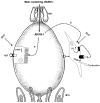Plant ureases and related peptides: understanding their entomotoxic properties
- PMID: 22474566
- PMCID: PMC3317107
- DOI: 10.3390/toxins4020055
Plant ureases and related peptides: understanding their entomotoxic properties
Abstract
Recently, ureases were included in the arsenal of plant defense proteins, alongside many other proteins with biotechnological potential such as insecticides. Isoforms of Canavalia ensiformis urease (canatoxin-CNTX and jack bean urease-JBURE-I) are toxic to insects of different orders. This toxicity is due in part to the release of a 10 kDa peptide from the native protein, by cathepsin-like enzymes present in the insect digestive tract. The entomotoxic peptide, Jaburetox-2Ec, exhibits potent insecticidal activity against several insects, including many resistant to the native ureases. JBURE-I and Jaburetox-2Ec cause major alterations of post-feeding physiological processes in insects, which contribute to, or can be the cause of, their entomotoxic effect. An overview of the current knowledge on plant urease processing and mechanisms of action in insects is presented in this review.
Keywords: Jaburetox-2Ec; Malpighian tubules; fluid secretion; midgut; plant defense; urease.
Figures


Similar articles
-
Structure-Function Insights of Jaburetox and Soyuretox: Novel Intrinsically Disordered Polypeptides Derived from Plant Ureases.Molecules. 2020 Nov 16;25(22):5338. doi: 10.3390/molecules25225338. Molecules. 2020. PMID: 33207637 Free PMC article. Review.
-
Invitro effect of Canavalia ensiformis urease and the derived peptide Jaburetox-2Ec on Rhodnius prolixus Malpighian tubules.J Insect Physiol. 2009 Mar;55(3):255-63. doi: 10.1016/j.jinsphys.2008.12.002. Epub 2009 Jan 20. J Insect Physiol. 2009. PMID: 19121321
-
Interaction of jack bean (Canavalia ensiformis) urease and a derived peptide with lipid vesicles.Colloids Surf B Biointerfaces. 2016 Sep 1;145:576-585. doi: 10.1016/j.colsurfb.2016.05.063. Epub 2016 May 25. Colloids Surf B Biointerfaces. 2016. PMID: 27281243
-
Jaburetox-2Ec: an insecticidal peptide derived from an isoform of urease from the plant Canavalia ensiformis.Peptides. 2007 Oct;28(10):2042-50. doi: 10.1016/j.peptides.2007.08.009. Epub 2007 Aug 17. Peptides. 2007. PMID: 17875343
-
Ureases as multifunctional toxic proteins: A review.Toxicon. 2016 Feb;110:90-109. doi: 10.1016/j.toxicon.2015.11.020. Epub 2015 Dec 12. Toxicon. 2016. PMID: 26690979 Review.
Cited by
-
Humoral and cellular immune responses induced by the urease-derived peptide Jaburetox in the model organism Rhodnius prolixus.Parasit Vectors. 2016 Jul 25;9(1):412. doi: 10.1186/s13071-016-1710-3. Parasit Vectors. 2016. PMID: 27455853 Free PMC article.
-
Structure-Function Insights of Jaburetox and Soyuretox: Novel Intrinsically Disordered Polypeptides Derived from Plant Ureases.Molecules. 2020 Nov 16;25(22):5338. doi: 10.3390/molecules25225338. Molecules. 2020. PMID: 33207637 Free PMC article. Review.
-
Development of a qPCR assay to identify and differentiate insect-associated strains of the Serratia marcescens complex.J Vet Diagn Invest. 2025 Mar;37(2):234-243. doi: 10.1177/10406387241313448. Epub 2025 Jan 27. J Vet Diagn Invest. 2025. PMID: 39865995 Free PMC article.
-
3-to-1: unraveling structural transitions in ureases.Naturwissenschaften. 2013 May;100(5):459-67. doi: 10.1007/s00114-013-1045-2. Epub 2013 Apr 26. Naturwissenschaften. 2013. PMID: 23619940
-
Soyuretox, an Intrinsically Disordered Polypeptide Derived from Soybean (Glycine Max) Ubiquitous Urease with Potential Use as a Biopesticide.Int J Mol Sci. 2019 Oct 30;20(21):5401. doi: 10.3390/ijms20215401. Int J Mol Sci. 2019. PMID: 31671552 Free PMC article.
References
-
- Carlini C.R., Gomes C., Guimaraes J.A., Markus R.P., Sato H., Trolin G. Central nervous effects of the convulsant protein Canatoxin. Acta Pharmcol. Toxicol. 1984;54:161–166. - PubMed
-
- Carlini C.R., Guimaraes J.A. Plant and microbial toxic proteins as hemilectins—Emphasis on Canatoxin. Toxicon. 1991;29:791–806. - PubMed
-
- Follmer C., Barcellos G.B.S., Zingali R.B., Machado O.L.T., Alves E.W., Barja-Fidalgo C., Guimaraes J.A., Carlini C.R. Canatoxin, a toxic protein from jack beans (Canavalia ensiformis), is a variant form of urease (EC 3.5.1.5): Biological effects of urease independent of its ureolytic activity. Biochem. J. 2011;360:217–224. - PMC - PubMed
Publication types
MeSH terms
Substances
LinkOut - more resources
Full Text Sources

